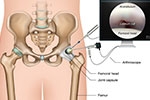Hip discomfort that lingers or interferes with mobility may signal the early stages of joint deterioration. Structural issues left unaddressed can progress into arthritis, leading to long-term damage. Fortunately, advances in arthroscopic techniques now make it possible to treat many of these problems early and effectively. Let’s explore how minimally invasive procedures can help preserve hip function and support joint health over time.
Preventing Arthritis at the Source
Many cases of hip arthritis begin with mechanical problems such as impingement or labral tears. These issues alter the biomechanics of the hip and accelerate cartilage wear. Early intervention through arthroscopy can correct these abnormalities-relieving symptoms and protecting the joint’s natural lining before permanent damage occurs.
Understanding Hip Arthroscopy
Hip arthroscopy is a minimally invasive procedure used to diagnose and treat problems within the hip joint. Through small incisions, a tiny camera and specialized instruments allow surgeons to access and repair damaged tissues without the trauma of open surgery. This technique offers a faster recovery, less scarring, and a more precise approach to preserving the hip joint
- Labral Reconstruction: When the acetabular labrum is too damaged to repair, advanced reconstruction using tendon grafts can restore joint stability and improve load distribution-key to preventing cartilage degeneration.
- Capsular Management (Repair & Plication): Proper handling of the hip capsule during arthroscopy (repairing or tightening it) improves joint stability and reduces the risk of microinstability, a contributor to early arthritis.
- Femoroplasty and Acetabuloplasty for FAI: Minimally invasive reshaping of the femoral head or acetabulum in patients with Femoroacetabular Impingement (FAI) can prevent cartilage wear and early-onset osteoarthritis.
- Chondral Repair Techniques: Methods such as microfracture, chondroplasty, and autologous chondrocyte implantation (ACI) during arthroscopy help repair focal cartilage damage and delay progression to arthritis.
Integrating biologics like platelet-rich plasma (PRP) and cell therapy during arthroscopy enhances healing and may delay degenerative changes. These innovative techniques continue to improve surgical success rates and post-operative function.
Early Intervention for Arthritis Prevention Is Key
Early intervention is key to preserving hip health and preventing long-term joint damage. If you're experiencing persistent discomfort or reduced mobility, it’s important to address symptoms before they progress.
The American Hip Institute specializes in advanced, minimally invasive treatments that restore function and help protect your joints for the future.
AUTHOR: Benjamin Domb, MD, is a board-certified, fellowship-trained orthopedic surgeon specializing in sports medicine and hip arthroscopy. He is the Founder and Medical Director of the American Hip Institute. Recognized among the top doctors in the U.S. by The New York Times, U.S. News & World Report, and Castle Connolly, Dr. Domb is known for his leadership in advancing hip preservation and minimally invasive surgical techniques.





